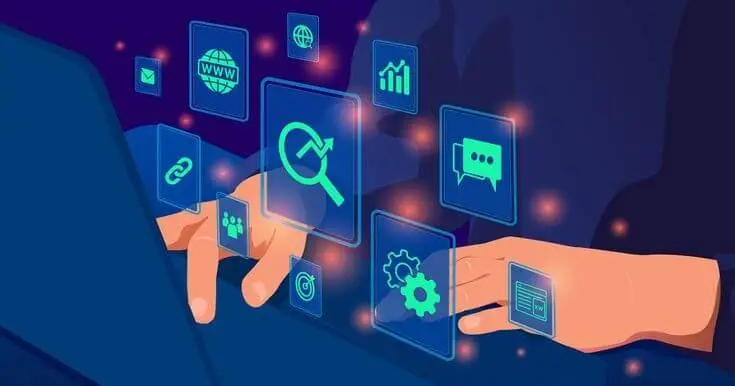
The Future of Web Services: Trends and Predictions for 2025 – HostNamaste
Introduction
Web development has been an area of explosive progress throughout its existence. It regularly experiences disruptions and game-changing breakthroughs. Processes get simpler, tool-building becomes more convenient, and user experience rules it all. At the beginning one needed to learn one or two programming languages, and get libraries and plugins to build a reliable website. Today anyone can use frameworks and blocks to build one from scratch.
ChatGPT has become a household name, and the drag-and-drop method is almost a must now for everything. No-code web development and app building are getting more traction. Clouds offer more services than ever, and interoperability of everything is the next big goal. And it is only a hint of what lies ahead in the year 2025 and beyond.
It’s not easy to make predictions of what may happen in the next year in web development, but certain trends are going steady. Let’s look closely at them now so that you know what to use for the advantage of your business and your clients in 2025.
Rise of AI and Machine Learning
AI (artificial intelligence) is all the rage now, and the recent drama in the industry prompts that this rage will only get stronger. Yes, we mean the ousting of Sam Altman from the position of OpenAI CEO and his fast triumphant return. People in the know agree that Altman’s return means that OpenAI’s strategy will change from mostly non-profit to for-profit. There will be a crop of new AI tools, most likely commercial, designed for business, education, and entertainment. So if you want to stay ahead, watch closely for new arrivals and use them in your product or service model.
Right now AI and machine learning revolutionize user experience, automation, and data processing, as well as education tools and creative processes. Many previously manual tasks that required a certain level of knowledge can now be automated safely. And it will not reduce the quality of work. In their turn, machine learning capacities help the automation tools to self-improve on the go.
Intelligent chatbots are used mainly for personalized shopping and content choosing on various platforms. Help in choosing what to buy, what to see, or services in real-time translation all work to the advantage of customers. It boosts customer satisfaction and increases revenues. As AI language models become better, chatbots become more impressive in unscripted communication. The use of such bots in customer service is predicted to grow to 95% by 2025.
Data gathering and automated communication are among the leading AI tasks but not the sole ones. AI can now help in web development as such. It can write portions of code or fix bugs, filter spam, and predict flaws in security systems. AI can serve as a virtual assistant (Alexa and Siri are AI-powered). Its capabilities in these areas are constantly under improvement. It means that the process of web development itself will get more efficient and more precise with its help.
A separate consideration should be given to ChatGPT and its role in web development. ChatGPT is the AI language model that can create coherent texts in response to prompts and engage in practically human-like dialogs. It is mostly used as a chat partner and a writing assistant. But it has a big future in customer service (and not only there). Its ability to imitate human communication helps to set customer support via multiple channels. Efficient support is part of a great customer experience that retains clients and attracts new ones.
Another promising area of the ChatGPT application is personalized education, where a unique tutor-like approach is offered to every student. There are some advances in this area, but the main breakthrough is yet to come. If you plan to build this kind of digital product, hurry up while the niche is still available.
Alongside the famous ChatGPT, there is an array of other instruments that can help web developers to do their job faster. Developers can get unique creative content made by their prompts from such tools as:
- Midjourney and DALL·E 2 (images),
- Descript and Wondershare Filmora (video creation),
- Desctopus and Beautiful.ai (slides and presentations),
- Spline AI and 3DFY.ai (3D models),
- Jasper, Copy.ai, Anyword (content).
This is just a handful of options for AI use in web development as such, and many more creative and commercial solutions are on their way.
The Growth of Cloud Computing
Cloud computing ‘or ‘cloud’ has changed the very way developers work and brought many positive changes to web development. So far, clouds provide databases, storage spaces, and processing and supporting powers over the Internet. So developers don’t need expensive physical storage and facilities to build and roll out their products. They need just a laptop and an Internet connection.
Clouds have brought down costs and allowed for better scalability and accessibility for remote teams. They also helped with collaborative web development and allowed to boost innovation.
It is the growing scalability and separation of development steps into even smaller modules that lead the trends for 2025 and beyond. Remember the names ‘serverless architecture’ and ‘microservices’. They are taking over the cloud world in the near future.
Serverless architecture means that developers move away even more from owning the infrastructure. Instead, they rent it from clouds, outsourcing the scaling problems and security matters. The task at the forefront will be innovative web design and code that is not limited by available facilities. Just choose a suitable cloud service and work on its basis.
Microservices mean that already outsourced services and solutions used as a whole will be divided into even smaller bits. In other words, when an application is designed as a collection of separate services, these services are further divided into blocks. These blocks are more flexible and are managed separately. And yes, they all belong to different teams and providers and exist as cloud services.
When working that way, a developer does not need to rebuild the whole product for changes or scaling. Individual elements (services) are changed as separate modules and the product is updated on the go. It reduces costs and amounts of work needed to be done. That’s why microservices architecture is booming and will continue to grow.
The Impact of IoT (Internet of Things)

The Internet of Things (IoT) has long become a staple of home organization. All or at least many home devices connect via the Internet and work in harmony. Smart homes, security circuits, additional care or monitoring options – they all depend on devices that can communicate via a hub. They are also smart enough to be preprogrammed.
So when web development meets IoT, it’s important to include this connectivity to physical objects in new applications. It can enhance their functioning.
AI is predicted to make IoT even more sophisticated because it will allow devices to process and analyze the data they have. Then they can make – or suggest – solutions or weighted decisions to an owner (like boosting fitness routine, for example). AI can be applied in many areas where this connectivity is required, from home to healthcare.
Yet AI is not the only trend to boom. As the number of devices grows, so does the need for their compatibility and interoperability. Unifying or simplifying the operational systems or managing apps is the next logical step. Developing tools for direct connectivity between devices is also a predictable shift.
Blockchain is also making its way into IoT. Blockchain technology can protect transmitted data from tampering and reduce the consumption of resources. Proofing of transactions (including financial ones) is crucial for the future of interconnected devices.
Increased Emphasis on Cybersecurity
The year 2023 was rich in large-scale security breaches. The victims were companies hosting huge amounts of personal user data, from financial to healthcare. So it all winds down to rolling out additional security measures and using the latest technologies available. That’s why among the key trends for 2025 in cybersecurity there will be implementation of AI, multi-factor authentication, and a boost in safety measures for IoT devices. Focus on mobile and database safety follows closely in tow.
AI in cybersecurity will definitely be used on both sides of the fence, by hackers and security teams alike. Generative AI can make attacks, especially phishing, more sophisticated. So applying AI in defensive and gaps-finding systems will become a must.
Multifactor authentication is already used by companies that previously relied on more traditional methods. The hard lessons of hacking attacks and data breaches showed the weakness of these methods. So be sure to integrate multifactor authentication into your products or website right from the start.
IoT devices that have become more complex and gained an independent connection to the Internet can be hacked as well. And if hacking a coffee machine sounds like a joke, then hacking a camera circuit, a smart lock, or a work laptop does not. The industry has not paid that much attention to this problem so far. So the next year will definitely see a boost in efforts focused on protecting communication protocols of devices. Blockchain can be helpful in it as well, so here two trends are converging. Blockchain can prevent data tampering and provide additional safety tools in IoT quite well.
As the web goes mobile further, so are dangers to data and money safety. Mobile security enhancement and tougher regulations are on the horizon. So new apps and mobile site versions need to be double–secure against threats. Multifactor authentication, anyone?
Database safety will become a headache for many companies that employ data as an operation tool. The zero trust principle can become ‘less than zero trust,’ i.e. no circuit or area in the company systems is ever considered protected enough. It will result in new approaches to identity and access management implementation.
There is also a consensus that state-sponsored large-scale hacker attacks or DDoS attacks will flood the world in 2025. They will be related to approaching elections in the USA, the UK, and India. This concern is not directly related to web development, yet it will impact the functioning of the global web community at large, so keep it in your focus.
The Expansion of Decentralized Services
Despite all the ups and downs of cryptocurrencies in 2023, blockchain has not lost its appeal for investors and developers. Its tamper-proof nature, smart contracts, and distribution of verification will play a big role in web development in 2025. The key trends to keep in mind are DeFi, CBDCs (Central Bank Digital Currencies), AI-enabled Blockchain, and Enterprise Blockchain.
DeFi stands for decentralized finance, and here blockchain technology is used for running financial transactions without intermediaries. It can give more freedom to users of financial services in the future, but for now, it is the combination of AI and DeFi that makes the biggest splash.
AI-powered security systems in DeFi guarantee more protection against fraudulent activities. They also ensure more compliance on the part of independent service providers (who do not relate or report to banks). In addition, DeFi is getting more simplified and user-friendly. Cross-chain integration becomes a founding principle. So as banks look to adopt their digital currencies, improved and easily integrated DeFi solutions are set to explode in the next year or two.
The never-ending popularity of cryptocurrency makes banks seriously consider their options. It led to the adoption of CBDCs (Central Bank Digital Currencies). On the one hand, these types of money will definitely have more trust from users who don’t trust technology alone. On the other hand, CBDCs that are based on blockchain will reshape the financial landscape. They introduce proofing and automating transactions and contracts on the go. The emergence of this type of money makes blockchain even more important for everyone using online transactions.
Pay attention to the topic of Enterprise Blockchain. All corporate areas will adopt some form of blockchain tools for security or for streamlining operations. The main advantage to use here is resistance to tampering. This feature will define the trends of corporate blockchain applications.
AI-powered blockchain is still under development but its potential is great in decision-making in uncertain conditions. Rigid consensus mechanisms of blockchain can win from the addition of intelligent adaptability. It will improve the scalability, adaptability, and efficiency of operations. Yet it will create new security challenges as well. The year 2025 will be interesting in this regard.
User Experience and Personalization
As you can get from all previous trends, AI is coming actively into all spheres of web development and web-based services. And the key trend here is customization and personalization. Main personalization happens in customer service and shopping experience. But other areas, like primary medical consultations or financial advice based on data analysis, are following in tow. What to look for (or what to implement in 2025) to stay attractive to customers?
- Chatbots that imitate human communication, flexible and adaptive
- Personal AI shopping assistants
- AI tools that can help ‘see’ products placed in the customer’s environment or used by a customer. First 3D tools are already out there, but they definitely need more fine-tuning.
- Customization of users’ accounts
- Inputs from analytical AI tools on how to simplify or optimize interfaces of your products or pages to retain customers
Today everything gets ‘custom’ and ‘personal’ and that is a good point in the world of vast automation and unification. Yet keep in mind that customization should not interfere with the main goals of your product (or with its concept). Besides, any creative input offered now by AI needs to be evaluated by a human developer to avoid potential damage to your product’s reputation. Marketers can tell a story or two on this point.
Integration of Web Services with Everyday Tools
Customization and automation of all possible processes help us streamline routes that we usually see as a given. Routine and repeated tasks, however small, can take up a lot of time and valuable energy that can get better use. Knowing that there is a tool to make life simpler is always good. Having it at hand to use seamlessly in your business processes is invaluable.
From automated data input to rolling out big marketing campaigns, everything can be automated. Tailored solutions can be combined into a configuration matching your particular business needs.
Consider the following examples.
Making labels for bulk shipping or creating custom labels for special orders can be a tedious task. Especially when it’s necessary to create them by hand. Data transfer, design, measurements – all these tasks require attention and time. Yet automated label creation and printing solve many problems. They reduce the number of errors and boost productivity. Meet the label printing software for this task that is easily integrated across platforms and is intuitive to use. Integrate FoxyLabels into your CRM or other online workspaces and you save yourself and your team lots of effort.
Need to share the Google Contacts database quickly and seamlessly? No time or staff to do it all manually (and imagine transferring thousands of personal cards with varying information)? The automated solution is here – SharedGoogle.com as a fast and efficient tool for the smooth transfer of data without errors or hassle. It seamlessly integrates with Google Contacts Rise of AI and Machine LearningThe Growth of Cloud Computing ITO Internet of Things and moves the data bulks to your CRM or other database.
Integration and collaboration in web development are on the rise, and if anything can be streamlined for the benefit of users, it will be. This is one of the key trends across fields, as we have already said, and these are examples of how it is successfully implemented.
Advancements in Data Processing and Analytics
Everything runs on big data, from AI to user experience to new concepts of solutions and apps. Amounts of data created daily are already counted in quintillions and that’s not the end. So the key problem that will be tackled in 2025 and beyond will be the processing of these amounts and their storage.
Stream data processing is what differentiates new approaches to big data usage. Earlier, the sheer capacity of facilities and volumes of data did not allow processing data in real-life mode. It was collected and processed, and what was not recorded was lost forever. New solutions for larger and smaller customers conduct data analysis at the same time as data gathering. This is a real breakthrough for many industries and web solutions, from fintech to smart homes. Solutions for small and middle businesses will get particular attention, come 2025.
Stream data processing goes hand in hand with the application of AI and ML in big data management. AI can successfully automate around 60% of data-processing work, thus reducing the general workload. Besides, ML can pick new skills from actual work learning how to find patterns and what to look for in the data pools. Then it will inform AI for better real-life decision making.
DaaS means data as a service, and it is one more trend that is going big. Cloud-based tools for collecting, storing, and managing data are already out there (think Microsoft Azure or Google BigQuery as examples). Yet the demand is only growing, and customization of data analysis tools is required, so new startups and solutions are on their way. Businesses and research institutions are ready to outsource facilities and processing capacities. It will free their time and money for actual work with big data.
And logically, one more trend is data lakes and data lakehouses. These are solutions for storing big data for further use but in different formats. Data lakes allow storing data in raw or semi-raw form, unstructured and unclassified, until further use. Data warehouses store data already organized and easy to manage. Lakehouses combine both approaches, but the technology is still under development. So the year 2025 will see more startups offering accessible lakehouse solutions. Probably there will be more experiments with cloud storage or search for other ways to make the technology more affordable.
Conclusion
As you see, the list of trends may go on and on and does not exhaust the topic, yet everywhere there is AI and ML. They will be applied across other trending technologies in web development, and a crop of new tools will arrive soon, customized for specific business or entertainment needs. It will be everywhere, from IoT to blockchain, and from there, the sky’s the limit in innovation and the creation of new solutions. So watch out and don’t be shy to use them in your products or try some new promising technology that is budding right now.




